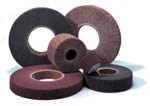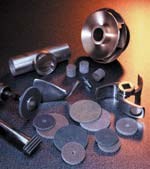How To Choose and Use Non-Woven Abrasives
Abrasive products are usually categorized as bonded abrasives and coated abrasives, but there is a third category that prepares and applies a final finish to the surface, these are non-woven abrasives . . .
Abrasive products used for finishing metal and non-metallic work pieces are generally categorized into two main groups: bonded abrasives (usually grinding wheels) and coated abrasives (belts, discs, sheets, etc.). These products are used to remove stock during the production process. But there is a third category of abrasives that serve a specialized and highly necessary function of preparing and applying the final surface finish, which can be critical to the performance and appearance of the work piece. These are non-woven abrasives.
These products are manufactured using a web of nylon fibers that are bonded together with synthetic resins. The fibers are impregnated with abrasive grain, producing a durable, cushioned, three-dimensional material that is pliable and conformable to the work piece.
Non-woven abrasives can be ideal for deburring, cleaning and imparting the desired finish to a variety of materials. A basic understanding of how these products are made and how they should be selected and used to their maximum benefit can help the metalworking manufacturer achieve the desired surface finish.
Role of Non-Woven Abrasives
The job of non-woven abrasives begins where other grinding products leave off. The relatively non-aggressive nature of nylon and the abrasive grit used in non-wovens make them excellent finishing tools.
With their open mesh construction, non-wovens are waterproof, washable and resilient. They resist loading and rusting and are nonconductive.
In the standard non-woven design, abrasive grain is uniformly dispersed throughout the nylon web, providing a continuous supply of new grain as the old grain and fibers wear away during use. While 60-80 grit abrasives are considered intermediate sizes in other products, they are considered coarse for non-woven products.
Non-wovens can be used on a range of metals, including aluminum, brass, copper, nickel, chrome plate, stainless steel and titanium, as well as other hard-to-grind materials such as ceramic, glass and plastic. Used wet or dry, non-wovens enable the user to achieve a consistent, uniform finish and conformability to irregular surfaces with minimal smearing and discoloration of the work piece.
Components of Non-Woven Abrasives
While non-wovens are made differently from conventionally coated abrasives, both products use many of the same abrasive minerals. Silicon carbide is sharper, cutsfaster and produces finer scratch patterns on most surfaces. Aluminum oxide is more durable and lasts longer. It is also more aggressive on hardened steel parts and produces less discoloration on aluminum.
Grit refers to the size of the abrasive grain impregnated into the nylon web (the lower the number, the larger the grains). Use of large particles (coarse grit) results in a more aggressive cut and a coarser finish. Smaller size particles in a non-woven product produce a fine surface finish, if all other conditions are equal.
| Grit Designation | Comparable Grit Mesh |
| Coarse (C) Medium (M) Fine (F) Very Fine (VF) Ultra Fine (UF) Micro Fine (SF) |
50-80 100-150 180-220 240-360 600 1000-1200 |
In specifying a conventional bonded or coated abrasive product, the purchaser selects a specific grit size, for example 120 grit. With non-woven abrasives, one of the following designations is used:
Density is another term used in specification that may be unfamiliar to someone who buys conventional abrasives. This refers to the amount of bonding agents and abrasive grain that have been compressed into the non-woven product. In general, harder density products cut faster, last longer and produce finer finishes than softer density products. However, softer densities offer more conformability to the work surface and less tendency to load or burn the work piece.
Sizing and bonding agents are two other factors in the design and manufacture of non-woven abrasives. Fiber size has a significant effect on the product's cutting characteristics, while the type of waterproof resin used to bond the fibers together and anchor the abrasive to the web can alter the characteristics of the product. The non-woven manufacturer selects the appropriate fiber size and bonding agent based on the intended application for the product; therefore, these components are not included in the product offering specifications.
A typical specification on a non-woven abrasive product might look like this:
8 A/O MED
The first symbol, 8, in this example, refers to the product's density. This can range from 2 (open/most conformable) to 9 (densest/most durable).
The second symbol, A/O, denotes the abrasive used. A or A/O refers to aluminum oxide.
The final designation, MED, denotes the grit size of the product.
Products Designed for Application Needs
The basic non-woven design lends itself to a variety of product types that meet a range of needs for metalworking and finishing. In general, non-woven abrasive products can be categorized into hand pads, rolls, discs, belts and wheels.
Hand pads are designed to provide excellent conformability and flexibility when hand finishing the work surface. They are generally available in 6 × 9 inch sizes, but are easily folded into smaller sizes as needed.
Role of Non-Woven Abrasives
Grit sizes range from coarse grit used in general cleaning to micro-fine grit for light scuffing and blending. In wet applications many users choose a non-woven hand pad as a replacement for steel wool because non-wovens are nonmetallic and therefore do not rust.
Rolls can be used for broader applications. Offering a more convenient source of the same cleaning and finishing performance as hand pads, rolls are available in 30-ft lengths and widths of 4 and 6 inches. The user simply cuts the roll to the required size for hand sanding or jitterbug sanding applications.
Non-woven discs come in a variety of designs for many cleaning and finishing applications. Arbor hole discs are used on high-speed grinders. Extra coarse grit products may be used for removing surface rust and residue, corrosion, light weld splatter and other surface contaminants. These discs can also be ganged with spacers to form a wide wheel used for sharp edge radiusing or deburring a decorative finish.
Right-angle discs are used on portable grinders for cleaning, deburring, blending and finishing, as well as for removing light rust, oxidation and coatings. The latest advance in grinding for these applications is the development of see-through discs for right angle grinding. These discs feature a specially shaped triangular profile and holes in the discs and back-up pads. This provides the operator with a clear view of the cutting surface, resulting in more controlled stock removal and a better surface finish. The holes also serve to disperse heat and loosen grinding material for a cooler finish and less power draw.
Non-woven belts are used on portable, bench and pedestal bench machines as an effective alternative to coated abrasive belts for cleaning, buffing and polishing. The conformability of the belts result in minimal gouging of the work piece, generating a more consistent finish.
Non-woven wheels
1. Flap wheels are fabricated by mounting sheets of non-woven material around a center hub. The tightly packed pieces form the spokes of a wheel. This is the best choice where conformability to a surface or a long-line brushed finish is required.
2. Convolute wheels are made by wrapping the non-woven material around a center core and bonding the layers together. These wheels can easily be shaped to match preformed parts.
3. Unified wheels are formed by compressing multiple layers of non-woven web material and bonding them together to form a wheel. They are ideal for general purpose cleaning and deburring.
Making the Most of Non-Woven Wheels
Of all the non-woven abrasive product types, the wheel family requires the most care in setup and operation. Maximum wheel life and best surface conditioning can be achieved by following these recommendations.
Wheel direction. Convolute wheels must always run the direction indicated by the arrow printed on the side of each wheel. Flap wheels and unified wheels can be run in either direction.
Wheel speed. The speed at which the wheel is run affects product finish, rate of cut and wheel life. Fast wheel speeds generally give harder action and a finer finish. Slower speeds give softer action and a coarser finish. Following are recommended operating speeds for most common applications.
| Cleaning/upgrading of surface conditions | 2,200-6,000 sfpm |
| Cut buffing on metal surfaces | 6,500-8,000 sfpm |
| Deburring | 5,500-8,000 sfpm |
| Decorative finishing | 500-3,000 sfpm |
| Imparting decorative finishes | 900-3,000 sfpm |
| Oxide removal | 3,500-6,500 sfpm |
Pressure. Light to medium pressure is recommended for most operations. Flap wheels require much lighter pressure to perform properly than other non-woven wheels. Unified wheels can withstand much higher pressures in order to perform deburring jobs. In all cases, avoid excessive pressure, which may result in wheel deformation and damage to the work surface.
Feed speed. Feed speeds directly affect the number of pieces completed over a given time. Slow feed speed reduces the number of completed pieces, while producing a shorter scratch pattern. Slow feed speed also allows for longer dwell time and permits more work to be done on each piece.
Oscillation. Oscillation may be used to break up scratch lines and produce a more uniform finish. An increase in cut may also be experienced. A general starting point for oscillation is 3/8-inch amplitude at 200 cycles per min.
Lubricants. The use of lubricants, such as water, water-soluble oil and straight oil, will decrease the heat generated while running, improve the luster and reduce the surface finish. The higher the viscosity of the lubricant, the lower the surface finish (RMS value) produced.
This information will assist users in selecting non-woven abrasives to complement their bonded and coated abrasives. However, it is important to remember that changes in any one of the many factors discussed here can affect the surface finish of the work piece. Work in partnership with your supplier to make the best product and application choices by considering every facet of your operation. By taking this system approach, you will maximize the productivity of your non-woven abrasives applications.
To learn more visit Norton .
Related Content
How to Address Declining Powder Coating Coverage Over Time
Fine particles from reclaim could be to blame for powder coating problems that emerge over time. Avoid problems by keeping hooks clean, maintaining guns and using reclaim powder quickly to avoid accumulation of fines.
Read MoreSolvent Versus Aqueous: Busting the Myths
Is aqueous cleaning “greener” than solvent cleaning? Is solvent a more effective cleaner than aqueous? These and many other questions are answered here to debunk the misconceptions that many manufacturers have held onto for years.
Read MoreAn Overview of Electroless Nickel Plating
By definition, electroless plating is metal deposition by a controlled chemical reaction.
Read MoreRead Next
Education Bringing Cleaning to Machining
Debuting new speakers and cleaning technology content during this half-day workshop co-located with IMTS 2024.
Read MoreEpisode 45: An Interview with Chandler Mancuso, MacDermid Envio Solutions
Chandler Mancuso, technical director with MacDermid Envio discusses updating your wastewater treatment system and implementing materials recycling solutions to increase efficiencies, control costs and reduce environmental impact.
Read MoreA ‘Clean’ Agenda Offers Unique Presentations in Chicago
The 2024 Parts Cleaning Conference, co-located with the International Manufacturing Technology Show, includes presentations by several speakers who are new to the conference and topics that have not been covered in past editions of this event.
Read More
















.jpg;maxWidth=300;quality=90)









